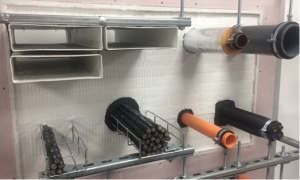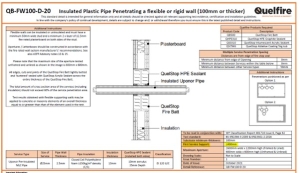Where should the first support be in relation to a service penetration fire seal? Firestopping FAQs

It is important that services are adequately supported to ensure that no load is transferred onto the fire stop seal, both during the normal operational life of the building and during a fire.
The service supports must therefore be capable of achieving the required fire rating of the fire stop and be installed on both sides of the seal.
The first service support measurement referred to on standard details is the maximum distance from the face of the fire stop seal to the service support – on both sides of the seal.
So, what distance does the first service support need to be?
The short answer is to check the specific tested detail. You need to check the particular service and scenario and remember the measurement referred to is the maximum distance that is permitted.
Service supports can be installed closer than that stated, so long as there is still enough space for the fire stop seal to be installed in accordance with the details.
Section 13.5 of the BS EN 1366-3:2021, the fire resistance test standard for service penetrations, effectively states that the first service support should be as tested, or closer.
13.5 Service Support Construction:
In walls, the distance from the surface of the separating element to the nearest support position for services/ cable carriers shall be the same as the minimum distance tested or less. For floors, in case of single layer plastic pipes, multilayer plastic pipes, composite pipes and MLC pipes or plastic conduits which are sealed by pipe closure devices in accordance with 3.1.19, the distance from the surface of the separating element to the first support shall be as tested or less, and the second support position shall be as tested or more.
In case of service support constructions for pipes with insulation the part of the service support directly in contact with the pipe (e.g., clamp) shall be in practice be protected by the same insulation as used for the pipe.
Why is the positioning of the first service support important?
It is important that services are adequately supported to ensure that no load is transferred onto the fire stop seal.
While service supports are commonly made from a non-combustible material such as steel, unprotected steel, for example, will generally lose around 50% of its load bearing capability when it exceeds temperatures of approximately 550°C.
Typically, a fire will greatly exceed this temperature, potentially reaching more than 1000°C as defined by BS EN1366-3.
It has been established that long cable routes and pipe suspension systems, when exposed to fire, can produce major displacement or constraining forces, acting in a directional perpendicular to the plane of the penetration seal. This can result in premature failure.
When testing cable or pipes in accordance with BS EN1366-3, the test specimens are typically 500mm in length on both sides of the supporting construction. This replicates the vertical load acting on the penetration seal, which results from failure of the service supporting structure on the fire-exposed face.
While certain services manufacturers may state that supports can be certain distances apart, when it comes to the fire stop seal, the firestop seal service support requirements would take priority.
As an example, a sprinkler pipe manufacturer may suggest that 1000mm between pipe supports is permitted. However, the first service support either side of the wall would need to be in accordance with the tested fire stop detail e.g., within 400mm.
Ultimately, if products and systems are not installed in accordance with the tested scope of application then there is no real guarantee of how the system will perform in the event of a fire. Utilising primary test data and the manufacturer’s guidance helps to protect people and property.
Where can the first service support information be found?
Whilst there is a lot of information on a Quelfire Standard Installation Detail, the first service support information is always listed in the bottom right-hand table. Below is an example of our detail QB-FW100-D-20:

Typically, almost all of our tested applications will state <400mm but it is important to check the specific standard installation details as some details may state ≤250mm.
All our standard details can be located in the ‘Downloads – Standard Detail Drawings’ section on our website or you can use our helpful QuelSelector tool.
If you have any further questions, please don’t hesitate to get in touch with us at technical@quelfire.co.uk.

